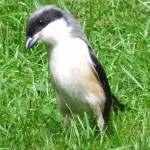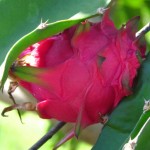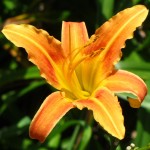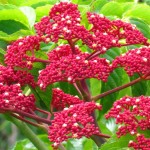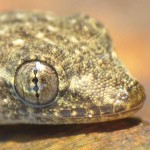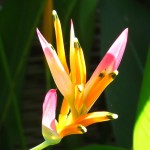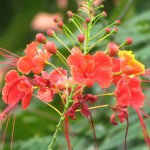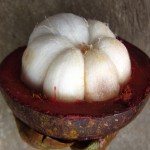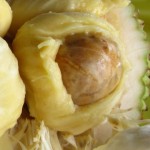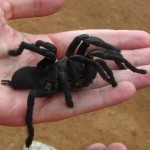Flora and Fauna of Tropical Asia
The fascinating world of tropical nature
Long-Tailed Shrike
Every morning at precisely 5:30, a harsh, loud rattling call of a long-tailed shrike (Lanius schach), gives us an untimely wake-up call. Standing on a branch of a tall tree just outside our first-floor bathroom, this bird is the earliest riser as it makes a quick tour of its territory. There it announces, in no uncertain terms, that this piece of land is its personal hunting ground and completely off-limits to any other member of its species. Personally, I don’t find the natural call of a shrike too unpleasant, but it certainly is a far cry from the… Continue reading
Fire Dragon Fruit
One of the more unusual fruits one often comes across while travelling through tropical Asia is the dragon fruit (Hylocereus undatus). This attractive-looking produce grows on a vine belonging to the Cactaceae family which seems somewhat out of place in the lush tropical vegetation of south-east Asia. Indeed, the plant originates in central America where it is known as “pitahaya”. The fact that it has been cultivated so successfully in many parts of Asia (including Cambodia, Indonesia, Malaysia, the Philippines, Sri Lanka, Vietnam, Thailand and Taiwan) shows its remarkable ability to survive in extreme conditions – from dry… Continue reading
Daylilies and Golden Needles
When a friend of mine suggested a weekend trip to Chike mountain (赤科山) in southeastern Taiwan’s Hualien county to check out the region’s famous daylilies, I was under the impression that we were going to see wild flowers growing freely in the area. Once on the spot, however, it became clear that these beautiful perennials, called orange daylilies (Hemerocallis fulva), are not only great to look at, they are also a sought-after delicacy known locally as “golden needle flower” (金針花). As such, the plant is commercially farmed and harvested for food. Still, in bloom the densely planted flowers… Continue reading
Leea Guineensis
I came across this spectacular flowering shrub during one of my cycling trips around Taitung in southern Taiwan. Two days later I was back with a camera to take some photographs and for the past hour or so I’ve been researching the Internet for clues about the name and origin of the plant. Without too much conviction I’ve settled on Leea guineensis, although it could also be Leea rubra. The former, as its Latin name suggests, comes from tropical Africa, but the latter is an Asian plant that grows throughout south-east Asia, New Guinea and northern Australia. Either… Continue reading
Common House Gecko
The common house gecko (Hemidactylus frenatus) is an unmistakable sight and sound throughout much of tropical Asia. Remarkably well adapted to human habitations where it easily climbs even the smoothest of surfaces, this nocturnal reptile hunts for insects that tend to congregate near light sources. It usually hides during the day. Its large and powerful eyes allow the animal to see any potential threat from a safe distance and move away in rapid if somewhat clumsy movement. The ability of a gecko’s feet to adhere to a variety of surfaces is well documented and the vocalisation it produces,… Continue reading
False Bird of Paradise
The Heliconiaceae family of plants is characterised by a large variety of astonishingly beautiful flowers of improbable shapes. The False Bird of Paradise (Heliconia psittacorum) is no exception. Also known as Parakeet Flower, Parrot’s Beak or Parrot’s Flower, this popular perennial originating from Central and South America provides a striking combination of colours – from its lovely pink bracts to strong orange-coloured flowers with dark green spots and white tips. It is widely cultivated in many parts of the tropics, often as hybrids or in colour varieties that differ considerably from the “original”, but still remain highly impressive.… Continue reading
Peacock Flower
One of the most popular ornamentals cultivated in many gardens around Cambodia is Peacock flower (Caesalpinia pulcherrima). This shrub produces striking flowers in red, orange, pink and yellow colours, and as a result of its beauty and ease of cultivation, it has spread to just about every corner of the tropical world. In fact, the plant has been grown so widely that its exact origin is a matter of dispute – some botanists believe it was first discovered in the Caribbean (one of the plant’s popular name is “Pride of Barbados”) or central America (where is is known… Continue reading
Mangosteen – World’s Best Fruit?
In “Exploring for plants”, a 1930 book written by American botanist David G. Fairchild, the author calls the mangosteen (Garcinia mangostana) “queen of tropical fruits”. This reference undoubtedly hints at the fruit’s excellent taste, but perhaps it also attempts to proliferate the (often quoted but unproven claim) that England’s Queen Victoria was particularly fond of this exotic fruit and even offered a large reward to anybody who could procure it for her. Many of the early explorers and botanists who tasted mangosteen gave it superb references. As an example, English explorer Frederick William Burbidge expressed the taste as… Continue reading
Tasting Cempedak
Another interesting fruit found in many parts of south-east Asia is cempedak (Artocarpus integer). The first time I noticed it in the markets of central Cambodia I thought the vendors were selling breadfruit, but later I started wondering whether it was some sort of a mini jackfruit or even a small durian. As it turned out, it was none of the three. Although related to jackfruit and breadfruit — all three belong to the Moracea family characterised by large stately trees that can reach up to 20 metres (in contrast, durian is a member of the Malvaceae… Continue reading
Cambodia’s Black Tarantula
The large, hairy and venomous tarantula spider is found throughout the world in as many as 900 species. Here in south-east Asia the most common of them is the Haplopelma genus. Its habitat ranges from Myanmar to Vietnam and as far south as Borneo where it is found burrowing deep in the soil of humid rainforests. The tarantula comes to the surface to hunt for insects, such as crickets and cockroaches, but it is also known to be able to capture larger prey, including lizards and mice. Some species are extremely aggressive and won’t hesitate to attack and bite a… Continue reading
